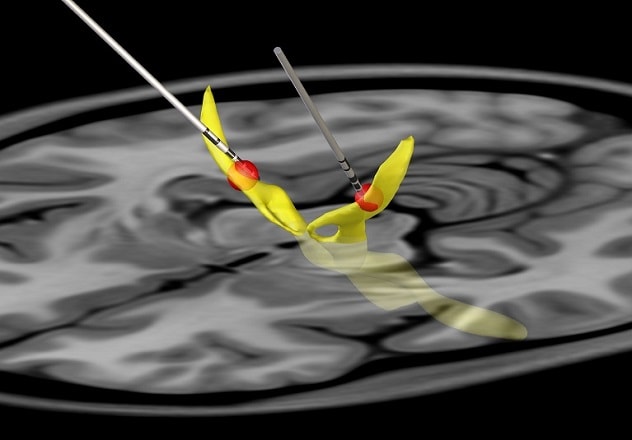June 16, 2023
Mayo Clinic's approach to movement disorders stresses precise diagnosis and treatment pathways. Sophisticated neurophysiological assessments and targeted deep brain stimulation (DBS) facilitate optimal care for individuals with movement disorders, most often Parkinson's disease or essential tremor (ET).
"Treating patients with movement disorders, especially as their symptoms become more severe, can be quite challenging. We often get referrals for diagnostic clarity. Since we're used to seeing these advanced, more complex cases, we can tailor our treatment approaches."
Neurologists, neurosurgeons and neuroradiologists collaborate to refine diagnoses and recommend treatments. The team has extensive experience using DBS to treat parkinsonism and ET.
Therapeutic techniques and technology are rapidly evolving. Mayo Clinic scientists have demonstrated improved outcomes from directed stimulation of the dentato-rubro-thalamic tract (DRTT) for patients with ET.
For individuals with Parkinson's disease, Mayo Clinic's campus in Florida is launching an advanced Parkinson's disease clinic.
"We know that these patients need more time for evaluation and a coordinated approach. That's what we will offer them," Dr. Tipton says.
Neurophysiological assessment
Mayo Clinic goes beyond standard techniques when evaluating individuals with movement disorders. Physician-scientists use movement neurophysiology laboratories where surface electromyography is performed.
"That allows us to capture the electrophysiological signature of different movements," Dr. Tipton says. "It can tell us where in the nervous system the tremor may originate, and that can help guide treatment decisions and DBS targeting."
Mayo Clinic also has gait labs, equipped with tools for recording every aspect of gait and balance. This resource enables clinicians to assess quantitative measurements of walking and balance. The gait lab at Mayo Clinic's campus in Florida has a large pressure-sensing walkway that detects changes in pressure underneath patients' feet as they walk.
"Synthesizing results from the gait lab allows us to come up with more-precise conclusions that we couldn't reach with a standard clinical exam," Dr. Tipton says.
Targeting the DRTT for ET
Approximately 10 million people in the United States have ET. The Food and Drug Administration approved DBS for the treatment of ET in 1997, yet usage lags.
"ET often runs in a family and can be viewed as just a family quirk rather than a treatable condition," Dr. Tipton says. "At the same time, ET can dramatically affect people's lives, and it tends to occur earlier in adulthood compared with Parkinson's disease. We think there are a lot of missed opportunities for treating ET."
First line therapy for ET is medication. But it is effective in only about half of patients, and half of patients who initially respond ultimately stop responding to medication. Thalamic DBS — the most widely used surgical treatment for ET — is highly effective for treating ET.
DBS that uses higher precision targeting can improve outcomes. In a pilot clinical trial, Mayo Clinic researchers showed that programming settings based solely on directionally targeting the DRTT produced greater tremor improvements compared with standard of care or sham programming. The findings were published in the April 2022 issue of The Neuroradiology Journal.
"We now know that refining our target to a small region within our initial target translates to better outcomes, not just for a few months but for years," Dr. Tipton says.
Advanced imaging and personalizing targets also can enhance outcomes. Mayo Clinic scientists have identified and validated a novel imaging-based marker for DBS treatment of ET. As explained in the May 2022 issue of Annals of Neurology, the imaging biomarker is a hypointense thalamic area identified on fast gray matter acquisition T1 inversion recovery (FGATIR) MRI.
Enfoque en la red de temblores

Enfoque en la red de temblores
Modelado específico para cada paciente de estimulación direccional optimizado para solaparse con la red de temblores, minimizando al mismo tiempo la estimulación de las estructuras adyacentes. El modelado direccional se basa en el modelado de las fibras del tracto dentado-rubro-talámico del paciente. Los modelos reducen la necesidad de realizar tediosos estudios monopolares y reducen las conjeturas en el programa de tratamiento del paciente.
"We have found that this FGATIR hypointensity reliably correlates with DRTT in our single-subject preoperative MR tractography, which can eliminate many of the inherent challenges and limitations of MR tractography," says Erik H. Middlebrooks, M.D., a neuroradiologist at Mayo Clinic's campus in Florida.
Mayo Clinic routinely uses this patient-specific targeting, which is described in the August 2022 issue of Annals of Neurology. "The approach leads to reduced operative times and improved tremor outcomes," Dr. Middlebrooks says.
Innovations in DBS systems further allow for improved positioning of electrodes.
"We can shape the electrical field in any way we want, to get the best outcomes," Dr. Tipton says. "The technology has advanced more in the past 10 years than it did in the previous 20 years. We are leveraging new technologies that can produce better and better outcomes for our patients."
For more information
Middlebrooks EH, et al. Directed stimulation of the dentato-rubro-thalamic tract for deep brain stimulation in ET: A blinded clinical trial. The Neuroradiology Journal. 2022;35:203.
Neudorfer C, et al. Personalizing deep brain stimulation using advanced imaging sequences. Annals of Neurology. 2022;91:613.
Middlebrooks EH, et al. Deep brain stimulation for tremor: Direct targeting of a novel imaging biomarker. Annals of Neurology. 2022;92:341.
Refer a patient to Mayo Clinic.